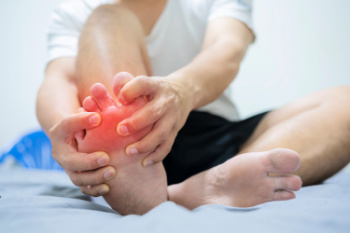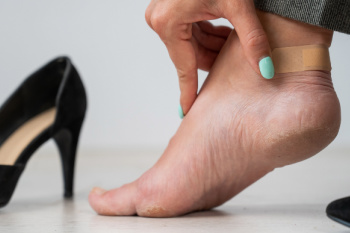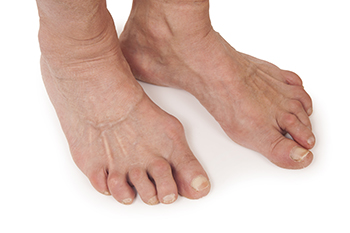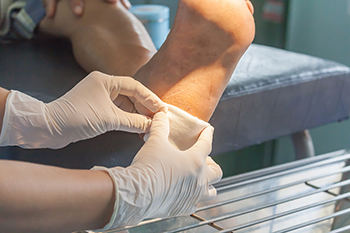Connect With Us
Blog
Items filtered by date: January 2025
Causes of Middle Toe Joint Pain and Its Symptoms

Middle-toe joint pain can result from various factors, often affecting daily activities and mobility. One common cause is arthritis, which leads to inflammation and stiffness in the joint. This condition can be a result of wear and tear over time or due to an autoimmune disorder. Another cause of this type of pain is a bunion, where a bony bump forms at the base of the big toe, as the result of misalignment of the toes. Trauma or injury, such as a sprain or fracture, can also lead to pain in the middle toe joint. Symptoms of middle toe joint pain include swelling, redness, and tenderness in the affected area. The pain typically worsens with movement, and it may become difficult to walk or wear shoes. In some cases, the joint may become stiff, limiting flexibility. If you have toe pain, it is suggested that you schedule an appointment with a podiatrist who can determine what the cause is, and offer viable treatment solutions.
Toe pain can disrupt your daily activities. If you have any concerns, contact Darron Barrus, DPM of Shelby Podiatry. Our doctor can provide the care you need to keep you pain-free and on your feet.
What Causes Toe Pain?
Most severe toe pain is caused due to a sports injury, trauma from dropping something heavy on the toe, or bumping into something rigid. Other problems can develop over time for various reasons.
Toe pain can be caused by one or more ailments. The most common include:
- Trauma
- Sports injury
- Wearing shoes that are too tight
- Arthritis
- Gout
- Corns and calluses
- Hammertoe
- Bunions
- Blisters
- Ingrown toenails
- Sprains
- Fractures (broken bones)
- Dislocations
When to See a Podiatrist
- Severe pain
- Persistent pain that lasts more than a week
- Signs of infection
- Continued swelling
- Pain that prevents walking
Diagnosis
In many cases the cause of toe pain is obvious, but in others, a podiatrist may want to use more advanced methods to determine the problem. These can range from simple visual inspections and sensation tests to X-rays and MRI scans. Prior medical history, family medical history, and any recent physical traumatic events will all be taken into consideration for a proper diagnosis.
Treatment
Treatments for toe pain and injuries vary and may include shoe inserts, padding, taping, medicines, injections, and in some cases, surgery. If you believe that you have broken a toe, please see a podiatrist as soon as possible.
If you have any questions please feel free to contact our office located in Alabaster, AL . We offer the newest diagnostic tools and technology to treat your foot and ankle needs.
Blisters on the Feet

Blisters on the feet are small, fluid-filled pockets that form between the layers of skin, typically caused by friction, pressure, or burns. Symptoms include pain, redness, swelling, and the appearance of a raised bubble on the skin. Blisters often occur from wearing tight shoes, ill-fitting socks, or prolonged walking or running. The most common causes are friction from new shoes or repetitive motion, such as running or hiking. Blisters can also result from hot weather, causing sweaty feet, or from burns or allergic reactions. Treatment usually involves protecting the blister with a bandage or blister pad, keeping it clean and dry, and avoiding further friction. In some cases, a podiatrist may drain the blister in a sterile environment to prevent infection or offer advice on better footwear. If blisters are recurrent or cause significant pain, a podiatrist can recommend customized solutions to prevent them. For this reason, if you have developed a foot blister, it is suggested that you schedule an appointment with a podiatrist.
Blisters are prone to making everyday activities extremely uncomfortable. If your feet are hurting, contact Darron Barrus, DPM of Shelby Podiatry. Our doctor can provide the care you need to keep you pain-free and on your feet.
Foot Blisters
Foot blisters develop as a result of constantly wearing tight or ill-fitting footwear. This happens due to the constant rubbing from the shoe, which can often lead to pain.
What Are Foot Blisters?
A foot blister is a small fluid-filled pocket that forms on the upper-most layer of the skin. Blisters are filled with clear fluid and can lead to blood drainage or pus if the area becomes infected.
How Do Blisters Form?
Blisters on the feet are often the result of constant friction of skin and material, usually by shoe rubbing. Walking in sandals, boots, or shoes that don’t fit properly for long periods of time can result in a blister. Having consistent foot moisture and humidity can easily lead to blister formation.
Prevention & Treatment
It is important to properly care for the affected area in order to prevent infection and ease the pain. Do not lance the blister and use a Band-Aid to provide pain relief. Also, be sure to keep your feet dry and wear proper fitting shoes. If you see blood or pus in a blister, seek assistance from a podiatrist.
If you have any questions, please feel free to contact our office located in Alabaster, AL . We offer the newest diagnostic and treatment technologies for all your foot care needs.
Rheumatoid Arthritis and Its Impact on the Feet

Rheumatoid arthritis, or RA, is an autoimmune disorder that causes chronic inflammation in the joints, leading to pain, swelling, and stiffness. The condition occurs when the immune system mistakenly attacks healthy joint tissues. RA can cause significant discomfort, with common symptoms including pain, redness, and swelling, especially in the toes and the balls of the feet. Over time, joint damage can lead to deformities, making walking and standing difficult. Several types of RA, ranging from mild to severe, each affect different joints. Risk factors for developing rheumatoid arthritis include family history, smoking, and gender, with women more likely to develop RA. Additionally, certain genetic markers may increase the likelihood of developing this condition. If your feet show signs of RA, it is strongly suggested that you consult a podiatrist who can help you monitor your foot health.
Because RA affects more than just your joints, including the joints in your feet and ankles, it is important to seek early diagnosis from your podiatrist if you feel like the pain in your feet might be caused by RA. For more information, contact Darron Barrus, DPM of Shelby Podiatry. Our doctor will assist you with all of your podiatric concerns.
What Is Rheumatoid Arthritis?
Rheumatoid Arthritis (RA) is an autoimmune disorder in which the body’s own immune system attacks the membranes surrounding the joints. Inflammation of the lining and eventually the destruction of the joint’s cartilage and bone occur, causing severe pain and immobility.
Rheumatoid Arthritis of the Feet
Although RA usually attacks multiple bones and joints throughout the entire body, almost 90 percent of cases result in pain in the foot or ankle area.
Symptoms
- Swelling and pain in the feet
- Stiffness in the feet
- Pain on the ball or sole of feet
- Joint shift and deformation
Diagnosis
Quick diagnosis of RA in the feet is important so that the podiatrist can treat the area effectively. Your doctor will ask you about your medical history, occupation, and lifestyle to determine the origin of the condition. Rheumatoid Factor tests help to determine if someone is affected by the disease.
If you have any questions please feel free to contact our office located in Alabaster, AL . We offer the newest diagnostic and treatment technologies for all your foot and ankle needs.
Treating a Cut on the Bottom of the Foot

A cut on the bottom of the foot can be painful and requires prompt treatment to prevent infection and promote healing. First, a podiatrist will clean the wound gently with mild soap and water to remove dirt and debris, followed by patting the area dry with a clean towel. If the cut is deep or bleeding heavily, gentle pressure is applied with a clean cloth or bandage to stop the bleeding. Once the bleeding is controlled, an antiseptic ointment is applied to prevent infection. The cut is covered with a sterile bandage or dressing, ensuring it is not too tight. It is beneficial to keep the foot elevated to reduce swelling and avoid putting weight on it to prevent further injury. It is wise to change the bandage regularly and monitor the wound for signs of infection, such as increased redness, swelling, or pus. If you have a cut on your foot, it is strongly suggested that you consult a podiatrist who can offer effective treatment solutions.
Wound care is an important part in dealing with diabetes. If you have diabetes and a foot wound or would like more information about wound care for diabetics, consult with Darron Barrus, DPM from Shelby Podiatry. Our doctor will assess your condition and provide you with quality foot and ankle treatment.
What Is Wound Care?
Wound care is the practice of taking proper care of a wound. This can range from the smallest to the largest of wounds. While everyone can benefit from proper wound care, it is much more important for diabetics. Diabetics often suffer from poor blood circulation which causes wounds to heal much slower than they would in a non-diabetic.
What Is the Importance of Wound Care?
While it may not seem apparent with small ulcers on the foot, for diabetics, any size ulcer can become infected. Diabetics often also suffer from neuropathy, or nerve loss. This means they might not even feel when they have an ulcer on their foot. If the wound becomes severely infected, amputation may be necessary. Therefore, it is of the upmost importance to properly care for any and all foot wounds.
How to Care for Wounds
The best way to care for foot wounds is to prevent them. For diabetics, this means daily inspections of the feet for any signs of abnormalities or ulcers. It is also recommended to see a podiatrist several times a year for a foot inspection. If you do have an ulcer, run the wound under water to clear dirt from the wound; then apply antibiotic ointment to the wound and cover with a bandage. Bandages should be changed daily and keeping pressure off the wound is smart. It is advised to see a podiatrist, who can keep an eye on it.
If you have any questions, please feel free to contact our office located in Alabaster, AL . We offer the newest diagnostic and treatment technologies for all your foot care needs.

